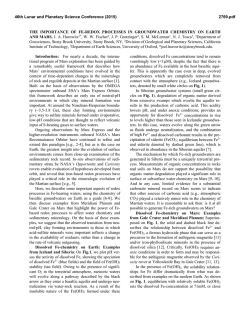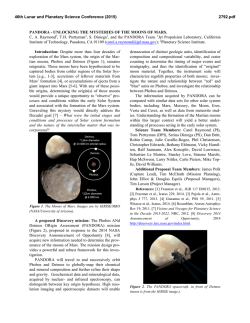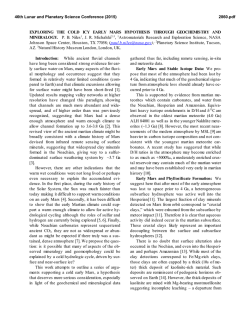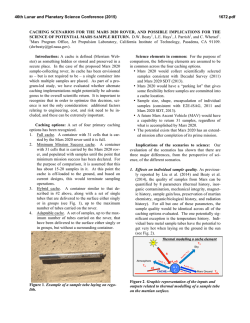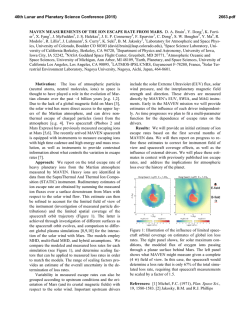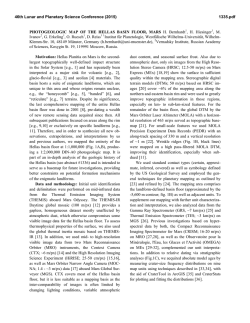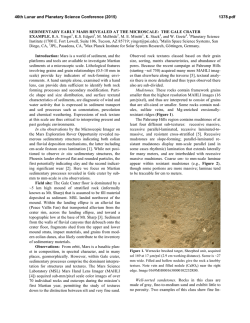
February 2015 - Central Arkansas Astronomical Society
The Volume 124 No. 2 February 2015 Bulle n Monthly newsle er of the Astronomical Society of South Australia Inc 23 years of public nights at The Heights p.5 Curiosity detects methane on Mars p.7 The planets for February 2015 p.10 Comet Lovejoy put in a great show p.11 Deep Sky ‐ observing Thor’s Helmet p.14 Registered by Australia Post Bulle n of the ASSA Inc Print Post Approved PP 100000605 1 Don’t miss Dr Graziella Caprarelli speak on the future of solar system exploration at the February General Meeting! Visit us on the web: February 2015 www.assa.org.au In this issue: ASTRONOMICAL SOCIETY of SOUTH AUSTRALIA Inc GPO Box 199, Adelaide SA 5001 The Society (ASSA) can be contacted by post to the address above, or by e‐mail to [email protected]. Membership of the Society is open to all, with the only prerequisite being an interest in Astronomy. Membership fees are: Full Member Concessional Member Subscribe e‐Bulle n only; discount $75 $60 $20 Concession informa on and membership brochures can be obtained from the ASSA web site at: h p://www.assa.org.au or by contac ng The Secretary (see contacts page). Member Submissions Submissions for inclusion in The Bulle n are welcome from all members; submissions may be held over for later edi ons. ASSA Ac vi es Details of general mee ngs, viewing nights etc 3 Reports Repor ng on Society ac vi es 4 Ar cle Paul Rogers tells of 23 years of Public Nights 5‐6 Ar cle Curiosity detects Methane on Mars 7‐8 Astro News Latest astronomical discoveries and reports 9 The Sky this month Solar System, Comets, Variable Stars, Deep Sky 10‐14 ASSA Contact Informa on 15 Members’ Image Gallery A gallery of members’ astrophotos 16 Wherever possible, text submissions should be sent via e‐ mail or posted on CD‐ROM in almost any word processing format and may s ll be submi ed handwri en or typed. Your name may be withheld only if requested at the me of submi ng. Images should be high resolu on and uncompressed, e.g. TIFF file formats, although high resolu on JPEGs are acceptable. Your full name and object designa on must be provided with each image and will be published. Equipment/exposure etc details are welcome but op onal. Adver sing & Classifieds Small adverts and classifieds are free for members (space permi ng). Commercial adver sing is available at a cost of $50.00 per quarter page per issue. Members are reminded that addi onal files, links, and resources will be avaibale on the ASSA website to complement material published in The Bulle n. All enquiries and submissions should be addressed to The Editor and preferably sent by e‐mail to: [email protected] Colorado Springs Astronomical Society www.csastro.org Important No ce Addi onal Online resources for The Bulle n Sister Society rela onships with: Orange County Astronomers www.ocastronomers.org Central Arkansas Astronomical Society www.caasastro.org For large files (e.g. on CD) or hardcopy items, post to: Joe Grida Editor, The Bulle n PO Box 682, Mylor SA 5153 Contribu ons should reach the Editor no later than the 7th of each month, for publica on in the following month’s issue of The Bulle n Cover photo: Comet C/2014 Q2 Lovejoy, imaged by Micheal Ma azzo Bulle n of the ASSA Inc 2 February 2015 Ac vi es February 2015 ‐ the month at a glance General Mee ng What’s hot in planetary science Wednesday, 4 February, 2015 @ 8:00pm Kerr Grant Lecture Theatre 2nd Floor, Physics Blg University of Adelaide North Terrace, Adelaide An overview and the future of solar system explora on In the past few months several successful missions to planets and objects of the solar system have made the news. Exo c names such as Mangalyaan, Rose a, Maven, have become common Guest Speaker: knowledge, and the achievements of Dr Graziella Caprarelli planetary scien sts and mission Associate Professor in Space Science engineers have once again bounced to the a en on of the general public. University of South Australia (See speaker bio on page 4) Through an overview of a number of significant results from selected missions, this talk will map the current scien fic knowledge of planetary systems, and highlight probable future The scien fic discoveries made by each areas of explora on, including their new mission of explora on of the solar challenges. system bring us closer to unravelling Planning on going observing? Save yourself unnecessary travel and me. If the weather looks doub ul where you are, check with the following people to see if the event is s ll on (or see www.assa.org.au a er 5pm). Stockport Observatory (DO 3‐13) Observatory 8528 2284 Lyn Grida 8388 5980 Tony Beresford 8338 1231 Heights Observatory (DO 3‐34) Robert Bronca 8266 7504 Black Forest the mechanisms of forma on and evolu on of our planetary system, provide clues to what extra‐solar systems look like, and direct our search for possible answers to the ques on of how and where life originated. Febuary 2015 Calendar Day Time Ac vity Wed 4 7:00pm Beginners’ Mee ng Wed 4 8:00pm General Mee ng Sun 8 2:30pm Telescope Clinic, The Heights Sat 14 8:30pm Members’ Viewing Night – Stockport Sat 14 8.30pm Member’s Viewing Night ‐ Riverland Sat 14 8:30pm Members’ Viewing Night – Tooperang Fri 20 8:30pm Public & Members’ Viewing – NYP Fri 20 8:30pm Public Viewing Night – The Heights Sat 21 8:30pm Public & Members’ Viewing – Whyalla Sat 21 8:00pm Members’ Viewing Night – Stockport Wed 25 7:30pm ASSA Council Mee ng Fri 27 7:30pm Deep Sky Imaging Group Fri 27 8:30pm Public Viewing Night, Henley Square Note: Times shown above and throughout this document are: 5 Oct 2014 to 5 Apr 2015 : South Australia Summer Time (UTC+10:30) 6 Apr 2015 to 3 Oct 2015 : South Australia Standard Time (UTC+ 9:30) 4 Oct 2015 to 3 Apr 2016 : South Australia Summer Time (UTC+10:30) Greg Weaver 8293 2341 Whyalla Ernie Ernes 8645 3613 Tooperang Jeff Lowrey 0429 690 610 Northern Yorke Peninsula Tony Henderson 0429 352 382 Riverland Tim Vivian 0407 800 225 Bulle n of the ASSA Inc Astronomy Educa on ‐ Beginners’ Talks Wednesday, 4 February, 2015 @ 7:00pm Kerr Grant Lecture Theatre University of Adelaide This month we explore the inner planets of the Solar Sys‐ tem from Mercury to Mars. These are the rocky planets which are similar to the Earth in composi on. We also look at the new class of Dwarf planets which include Pluto, Ceres and Eris. 3 February 2015 Reports and No ces Reports on recent ASSA ac vi es, and no ces of upcoming events Guest Speaker Biography Have you done your Police check yet? February 2015 General Mee ng You may recall that ASSA published a no fica on in the January 2014 Bulle n regarding Police Checks. The no ce advised all members that they will require a current Police Check (clearance) Cer ficate if they par cipate as a volunteer at any ASSA sanc oned public event. Although this is yet to be made mandatory by parliamentary legisla on, it was, and is now even more so in the light of recent events, only a ma er of me before this will be compulsory. Dr Graziella Caprarelli Dr Graziella Caprarelli is Inaugural Associate Professor in Space Science at the University of South Australia. Dr Caprarelli obtained her PhD in Earth Sciences from the University La Sapienza (Rome, Italy). A er two post‐doctoral appointments in Japan, she moved to Australia, first in Adelaide, and then to Sydney, where she worked at the University of Technology Sydney un l December 2013. Regardless, ASSA is s ll bound by a duty of care under the guidelines set by the Commissioner for Children, and also by our Insurance provider who state this clearly in our insurance policy. Consequently, ASSA Council passed a mo on that has made this a Policy that "all ASSA members who volunteer at any ASSA sanc oned public event hold a current Police Check Clearance Cer ficate". We gave ourselves un l the end of June 2014 for the majority of member volunteers to have completed this Police Check, but it would appear that quite a few members who kindly volunteer their me at these events have yet to meet this policy requirement. To date she has conducted research and published on the topics of volcanic processes on Earth and Mars, impact crater sta s cs, and Mar an ancient climate. She an cipates that her scien fic curiosity will lead her towards expanding her areas of inves ga on to other planets and objects of the solar system and beyond. Please refer to the member's sec on on our web site for the Instruc ons and Guidelines on how to apply for the Police Check Cer ficate. h ps://www.assa.org.au/media/58017/Police‐Checks‐ Process‐for‐Applicants‐ASSA‐version.pdf Alterna vely , please contact Paul Rogers directly by email and he can email you the guidelines as well as the applica on form. [email protected] Telescope clinic Please note that there is NO FEE to do this, as ASSA has been granted a V.O.A.N. number that means we don't pay for members who volunteer, to have this check done. Did Santa bring you a new telescope for Christmas? Or has your telescope languished in the garage or shed because you didn’t know how to set it up? Is something not quite right with your telescope? Out of collima on? Get answers to all these ques ons, and many more at the first Telescope Clinic of 2015. Get your copy now, and be prepared for 2015. Available at the General Mee ngs or by mail order. $23 + $4 postage The Heights Observatory Sunday, 8 February 2015 2:30pm Bulle n of the ASSA Inc Email [email protected] to place your order. 4 February 2015 Well, …..that was fun! Paul Rogers recounts his 23 years as co‐ordinator of The Heights public viewing nights As most of you know, I’ve handed over the reigns as the co‐ ordinator of the public nights at The Heights to the willing and capable Robert Bronca – who has also been elected a Council member for 2015. Robert, together with his partner Corrie and their children, have been assis ng at The Heights regularly for some me. Please con nue to support Robert with the public viewing nights, just as many members have supported and assisted me over many years. In fact, on behalf of ASSA, I have been co‐ordina ng and “running” the public nights at The Heights for 23 years, so with other developments looming (family, grandchild coming, re rement etc), I decided it was me to step back a li le and encourage others to have a turn. It’s hard to believe I have been doing this for 23 years, but when I think about it and “look back” there are certain memories and reminders that do indeed indicate the me has passed. Here’s a few snippets from those 23 years. When I started, the Emanuel Papaelia domed observatory was newly constructed, there were no fences around The Heights school, and the 2nd Observatory – The Inghams Rooms was s ll 9‐10 years away from construc on. Under Emanuel’s guidance and encouragement, there was a very ac ve student involvement, and it was not long before the school was gaining recogni on and praise for its forward thinking in science and especially, astronomy. Accurate records for some of these numbers (public and members) weren’t kept in the first few years, but from 1994 onwards to December 2014 this is what happened…… The regular monthly public nights also soon became well known, both in the local area and more broadly thanks to various publica ons that gave advanced no ce of these nights. The first public nights were run by members such as Joe & Lyn Grida, Trish Ellin and Manuel Papaelia, – Joe Grida s ll writes regular ar cles for the Adver ser, and this has been a con nuing source in adver sing these nights. 4,547 members of the public a ended at The Heights assisted by 1,175 members – a lot of members on a regular basis and some who are s ll coming to help since the start. $11,054 was taken in cket sales. These numbers were actually over 142 “go ahead nights” as there were another 137 nights cancelled. There was a 12 year period between 2004 to the end of 2012 when there were more cancella ons than go aheads. Students, with their parents, and also science teachers and principals have all “moved on” since those early days, but there has been a constant renewal of these people, some with a passing interest, and luckily others with a more enthusias c outlook and willingness to contribute and work with ASSA to ensure the success of the facili es. Anyway, enough of this boring stats stuff. Some memorable nights I recall… Probably, the present me sees some of the strongest involvement, with the current facili es and equipment a reflec on of the dedica on and hard work by Andrew Cool and by parents and the school – assisted at various mes by ASSA members. The only person I’m aware of that fell down the stairs – my own daughter Claire when she was about 12 years old (now 32) – tried to get down quickly and uninten onally succeeded by slipping and bouncing down every step on her backside (she survived but was quite embarrassed). So what happened at the public nights over the last 23 years? Then there was the me the crea onist visited. Showed him some distant objects that exceeded (in light me) his belief Bulle n of the ASSA Inc 5 February 2015 Well, …..that was fun! Paul Rogers recounts his 23 years as co‐ordinator of The Heights public viewing nights of the age of everything. He was quite ma er‐of‐fact in in the dome (literally) when some idiots lobbed fireworks sta ng that what he saw was fantas c, but couldn’t be there under my car that fortunately rolled out and off they went at that distance! sending colourful “stars” all over the dome, the me some young girl guides embarrassed me (luckily it was dark), by Who was at the official opening of the Ingham Rooms joining hands in a circle around me in the dome and singing observatory and remembers the egg missiles lobbed on the a thank you song. assembled dignitaries from some well hidden young pranksters behind a neighbouring fence? But probably best of all, are the comments of awe and wonder from (especially young) people who have seen And the rather inebriated young man that was becoming something in the eyepiece that has really amazed them, and very vocal on a very busy night – demanding that he have his their enthusias c responses are worth all the me and effort turn. I took on a new role that night in being Mr Policeman of the last 23 years. and luckily he quietened down and did what he was told. Of course, it goes without saying, ‐ and I’m not going to try In a similar vein – David Benn and Michael Williams assisted and name them all – that none of these nights would have in (last thing at night when everyone had le ) flushing out 3 been a success without all the help of many dedicated young people that had broken into a school equipment shed members of ASSA who have – and s ll do – a end regularly and were in the process of damaging the contents before we and make the experience for the public, one to remember intervened and they were scared off. and enjoy. Sadly some of those members who used to assist are no longer with us, but I remember them all fondly. There are many other memories…. The night I bogged the Magna, the visit by a cycling club in the pouring rain, the Thank you everyone for your contribu ons at The Heights police officer who snuck up the stairs and gave me a fright over the years that I represented ASSA as the co‐ordinator for the public viewing nights …. it was fun. when he challenged my (early by myself se ng up) presence, and then stayed for some twilight views of Saturn. (and, thank you Paul for the great work you did!... Ed) the me the seismograph needle was going ballis c, and I dismissed it as “local interference” – yes, egg on face, next day an earthquake had been reported, the night I saw stars (Photos supplied by Andrew Cool). Bulle n of the ASSA Inc 6 February 2015 Curiosity detects methane spike on Mars Dr Tony Phillips from Science@NASA reports on the latest discovery at Mars Dec. 16, 2014: NASA's Mars Curiosity rover has measured a tenfold spike in methane, an organic chemical, in the atmos‐ phere around it and detected other organic molecules in a rock‐powder sample collected by the robo c laboratory’s drill. "This temporary increase in methane ‐‐ sharply up and then back down ‐‐ tells us there must be some rela vely localized source," said Sushil Atreya of the University of Michigan, Ann Arbor, and Curiosity rover science team. "There are many possible sources, biological or non‐biological, such as interac on of water and rock." been delivered to Mars by meteorites. Organic molecules, which contain carbon and usually hydrogen, are chemical building blocks of life, although they can exist without the presence of life. Curiosity's findings from analyzing samples of atmosphere and rock powder do not reveal whether Mars has ever harbored living microbes, but the findings do shed light on a chemically ac ve modern Mars and on favorable condi ons for life on ancient Mars. Researchers used Curiosity’s onboard Sample Analysis at Mars (SAM) laboratory a dozen mes in a 20‐month period to sniff methane in the atmosphere. During two of those months, in late 2013 and early 2014, four measurements averaged seven parts per billion. Before and a er that, readings averaged only one‐tenth that level. "We will keep working on the puzzles these findings present," said John Grotzinger, Curiosity project scien st of the California Ins tute of Technology in Pasadena (Caltech). "Can we learn more about the ac ve chemistry causing such Curiosity also detected different Mar an organic chemicals fluctua ons in the amount of methane in the atmosphere? in powder drilled from a rock dubbed Cumberland, the first Can we choose rock targets where iden fiable organics have defini ve detec on of organics in surface materials of Mars. been preserved?" These Mar an organics could either have formed on Mars or Above: This image illustrates possible ways methane might be added to Mars' atmosphere (sources) and removed from the atmosphere (sinks). NASA's Curiosity Mars rover has detected fluctua ons in methane concentra on in the atmosphere, implying both types of ac vity occur on modern Mars. Bulle n of the ASSA Inc 7 February 2015 Curiosity detects methane spike on Mars Dr Tony Phillips from Science@NASA reports on the latest discovery at Mars Researchers worked many months to determine whether any of the organic material detected in the Cumberland sample was truly Mar an. Curiosity’s SAM lab detected in several samples some organic carbon compounds that were, in fact, transported from Earth inside the rover. However, extensive tes ng and analysis yielded confidence in the detec on of Mar an organics. and were freed when SAM heated it, yielding informa on about the history of Mar an water. The ra o of a heavier hydrogen isotope, deuterium, to the most common hydrogen isotope can provide a signature for comparison across different stages of a planet's history. "It's really interes ng that our measurements from Curiosity of gases extracted from ancient rocks can tell us about loss of water from Mars," said Paul Mahaffy, SAM principal inves gator of NASA’s Goddard Space Flight Center in Greenbelt, Maryland, and lead author of a report published online this week by the journal Science . Iden fying which specific Mar an organics are in the rock is complicated by the presence of perchlorate minerals in Mar an rocks and soils. When heated inside SAM, the perchlorates alter the structures of the organic compounds, so the iden es of the Mar an organics in the rock remain uncertain. The ra o of deuterium to hydrogen has changed because the lighter hydrogen escapes from the upper atmosphere of Mars much more readily than heavier deuterium. In order to go back in me and see how the deuterium‐to‐hydrogen ra o in Mar an water changed over me, researchers can look at the ra o in water in the current atmosphere and water trapped in rocks at different mes in the planet’s history. "This first confirma on of organic carbon in a rock on Mars holds much promise," said Curiosity par cipa ng scien st Roger Summons of the Massachuse s Ins tute of Technology in Cambridge. "Organics are important because they can tell us about the chemical pathways by which they were formed and preserved. In turn, this is informa ve about Earth‐Mars differences and whether or not par cular environments represented by Gale Crater sedimentary rocks were more or less favorable for accumula on of organic materials. The challenge now is to find other rocks on Mount Sharp that might have different and more extensive inventories of organic compounds." Mar an meteorites found on Earth also provide some informa on, but this record has gaps. No known Mar an meteorites are even close to the same age as the rock studied on Mars, which formed about 3.9 billion to 4.6 billion years ago, according to Curiosity’s measurements. The ra o that Curiosity found in the Cumberland sample is about one‐half the ra o in water vapor in today's Mar an Researchers also reported that Curiosity's taste of Mar an water, bound into lakebed minerals in the Cumberland rock atmosphere, sugges ng much of the planet's water loss occurred since that rock formed. However, the measured more than three billion years ago, indicates the planet lost much of its water before that lakebed formed and con nued ra o is about three mes higher than the ra o in the original water supply of Mars, based on assump on that supply had to lose large amounts a er. a ra o similar to that measured in Earth's oceans. This SAM analyzed hydrogen isotopes from water molecules that suggests much of Mars' original water was lost before the rock formed. had been locked inside a rock sample for billions of years Le : This graphic shows tenfold spiking in the abundance of methane in the Mar an atmosphere surrounding NASA's Curiosity Mars rover, as detected by a series of measurements made with the Tunable Laser Spectrometer instrument in the rover's Sample Analysis at Mars laboratory suite. Image Credit: NASA/JPLCaltech Bulle n of the ASSA Inc 8 February 2015 Astro News Interes ng news stories sourced around the world Researchers detect possible signal from dark ma er Scien sts have picked up an atypical photon emission in X‐rays coming from space, and say it could be evidence for the existence of a par cle of dark ma er. If confirmed, it could open up new perspec ves in cosmology. Could there finally be tangible evidence for the existence of dark ma er in the Universe? A er si ing through reams of X ‐ray data, scien sts in EPFL's Laboratory of Par cle Physics and Cosmology (LPPC) and Leiden University believe they could have iden fied the signal of a par cle of dark ma er. analyzing X‐rays emi ed by two celes al objects ‐‐ the Perseus galaxy cluster and the Andromeda galaxy. A er having collected thousands of signals from the ESA's XMM‐ Newton telescope and eliminated all those coming from known par cles and atoms, they detected an anomaly that, even considering the possibility of instrument or measurement error, caught their a en on. This substance, which up to now has been purely hypothe cal, is run by none of the standard models of physics other than through the gravita onal force. Their research will be published next week in Physical Review Le ers. The signal appears in the X‐ray spectrum as a weak, atypical photon emission that could not be a ributed to any known form of ma er. Above all, "the signal's distribu on within the galaxy corresponds exactly to what we were expec ng When physicists study the dynamics of galaxies and the with dark ma er, that is, concentrated and intense in the movement of stars, they are confronted with a mystery. If center of objects and weaker and diffuse on the edges," they only take visible ma er into account, their equa ons explains Ruchayskiy. "With the goal of verifying our findings, simply don't add up: the elements that can be observed are we then looked at data from our own galaxy, the Milky Way, not sufficient to explain the rota on of objects and the and made the same observa ons," says Boyarsky. exis ng gravita onal forces. A new era There is something missing. From this they deduced that The signal comes from a very rare event in the Universe: a there must be an invisible kind of ma er that does not photon emi ed due to the destruc on of a hypothe cal interact with light, but does, as a whole, interact by means of par cle, possibly a "sterile neutrino." If the discovery is the gravita onal force. Called "dark ma er," this substance confirmed, it will open up new avenues of research in appears to make up at least 80% of the Universe. par cle physics. Apart from that, "It could usher in a new era in astronomy," says Ruchayskiy. "Confirma on of this Andromeda and Perseus revisited discovery may lead to construc on of new telescopes Two groups have recently announced that they have specially designed for studying the signals from dark ma er detected the much sought a er signal. One of them, led by par cles," adds Boyarsky. "We will know where to look in EPFL scien sts Oleg Ruchayskiy and Alexey Boyarsky, also a order to trace dark structures in space and will be able to professor at Leiden University in the Netherlands, found it by reconstruct how the Universe has formed." Video: h ps://www.youtube.com/watch?v=aogKkzESbgs&feature=youtu.be Story Source: Ecole Polytechnique Fédérale de Lausanne. "Researchers detect possible signal from dark ma er." Science‐ Daily. 11 December 2014. www.sciencedaily.com/releases/2014/12/141211115520.htm Le : Could there finally be tangible evidence for the existence of dark ma er in the Universe? A er si ing through reams of X-ray data, scien sts in EPFL's Laboratory of Par cle Physics and Cosmology (LPPC) and Leiden University believe they could have iden fied the signal of a par cle of dark ma er. Credit: Image courtesy of Ecole Polytechnique Fédérale de Lausanne (screen shot from video) Bulle n of the ASSA Inc 9 February 2015 Solar System Highlights by Joe Grida The major planets during February 2015 There are 2 brilliant beacons in our night sky this February. Venus in the west, and Jupiter in the north‐east. 1.2. Combine that with its proximity to the western horizon soon a er sunset, and it is really too hard to observe. Mercury is a morning object this month, and reaches its greatest elonga on west of the Sun (27o)on the 24th of February. At the start of astronomical twilight at 5:30am ACDT, you’ll find the li le mag 0.1 planet in Capricornus, just 7o above the eastern horizon. Jupiter, the colossus of the solar system, comes to opposi on on February 6th, so it is visible from dusk un l dawn. During the first half of February, it retrogrades from Leo back into Cancer, its brightness peaking at magnitude – 2.6. Its equatorial diameter is 45 arc‐seconds, so once Jupiter is high in the sky on a night of steady atmosphere, a good medium‐size telescope will reveal dark belts, light zones, and hints of luxurious details within them. Jupiter is at a fairly high northern declina on during this appari on, so it never really rises more that about 40o above the horizon. Venus dominates the western evening sky. It shares the constella on of Aquarius with Neptune and Mars. On February 1, the planet shines at magnitude –3.9, and displays an almost full disk of 11.1 arc seconds, at a distance of 1.5AU. It has a close encounter with Mars on the 22nd at a distance of only 0.4o. They will make a good colour contrast in binoculars. With Mars shining at just mag 1.2, it is 100 mes fainter than Venus! The night before, the thin crescent Moon joins Venus and Mars in the twilight for a great photo opportunity. Saturn rises around 1:30am ACDT at the start of February, and midnight at the end of the month. You’ll find the glamour‐puss of the solar system si ng on the head of Scorpius. It shines at magnitude +0.5, and its equatorial diameter is only 16″. Even at a distance of 10.3AU, it s ll manages to look larger than Venus, nearly 7 mes closer! A Mars starts the month in Aquarius, but crosses the border telescope shows its gorgeous rings. They are lted almost into Pisces on the 11th of February. The red planet has a ny 25° from an edgewise presenta on, prac cally the most diameter of 4.2 arc‐seconds, and shines at a magnitude of open they ever become (27o). Dairy of phenomena February 2015 d 1 3 4 5 6 6 9 11 12 13 14 15 17 18 19 19 20 21 21 22 24 25 25 26 27 h(UT) 17 Venus 0.8oS of Neptune 23 FULL MOON 5 Jupiter 5.0oN of Moon 5 Regulus 3.8oN of Moon 6 Moon at apogee 18 Jupiter at opposition 19 Spica 3.2oS of Moon 8 Mercury stationary 3 LAST QUARTER 0 Saturn 2.1oS of Moon 16 Moon furthest South (-18.4o) 23 Pluto 3.0oS of Moon 5 Mercury 3.4oS of Moon 23 NEW MOON 7 Moon at perigee 10 Neptune 3.6oS of Moon 23 Venus 2.0oS of Moon 0 Mars 1.5oS of Moon 22 Uranus 0.3oS of Moon 5 Venus 0.4oS of Mars 19 Mercury greatest elong W(27o) 17 FIRST QUARTER 23 Aldebaran 1.0oS of Moon 4 Neptune at conjunction 7 Moon furthest North (18.3o) Bulle n of the ASSA Inc Uranus is some 4° above and to the right of Venus at the end of the month, pre y low for finding a 6th‐magnitude speck in the a erglow of sunset. Uranus will pass close to Venus on March 4th. Neptune starts the month near Venus, but at 8th magnitude it’s very difficult to see in the evening twilight. It’s invisible the rest of the month, going through conjunc on with the Sun on February 26th. Happy observing! Moon Phases ‐ February 2015 10 February 2015 Southern Hemisphere Comets by Michael Ma azzo A roundup of bright and telescopic comets visible for southern hemisphere observers Comets in 2015 Unless you are visi ng Northern Australia or parts further north, the comet Lovejoy show is over. Let us take a look at what's ahead for 2015, including another 2 poten al naked eye comets! C/2014 Q2 Lovejoy As of wri ng this in mid January, the comet was an easy naked eye object in the northern evening sky a er sunset. It peaked at magnitude 4.0, with an ion tail traceable to 7 degrees in length photographically, as it passed by Earth on January 7 at 0.47AU. Visually the ion tail was only a couple of degrees long and required a dark sky to see it well. The coma size was a whopping 25 arcminutes, almost as large as the Moon, with a bright stellar "nucleus" in telescopes. The ion tail dynamics were a treat to photograph, with frequent mul ple streamers and disconnec on events on offer. Disconnec on events are caused by solar wind striking the comet, stripping the ion tail away from the nucleus. A new ion tail rapidly replaces the old one. 10P Tempel Was discovered in 1873 as a 9th magnitude object and has an orbital period of 5.5 years. The appari on in 2015 is an average one, with the comet closest to the Earth on May 24 at 1.31AU whilst arriving at perihelion on November 14 at 1.41AU. It will be observable as a magnitude 10 object in the constella on of Ophiuchus, during October‐November evening skies. Very interes ngly, this comet displays a fine dust "trail", detectable in CCD images. 22P Kopff Was discovered in 1906 as an 11th magnitude object. The perihelion distance was at 1.70AU. Following an encounter with Jupiter in 1942, its period was Above: A wide field photo by Michael Ma azzo, taken on 11 January, 2015 showing Orion, Taurus and the comet. 3x30 second exposure with a 50mm lens Bulle n of the ASSA Inc 11 February 2015 Southern Hemisphere Comets by Michael Ma azzo A roundup of bright and telescopic comets visible for southern hemisphere observers reduced to 6.4 years and perihelion decreased to 1.5AU. This year the comet is closest to the Earth on April 27 at 1.39AU, then closest to the Sun on October 25. The appari on is not very favourable but it will be brightest in October as a magnitude 10 object in the constella on of Ophiuchus, in the same vicinity as 10P Tempel. An encounter with Jupiter in 2026 will further reduce the perihelion distance to 1.31AU, and again in 2038, to 1.18AU. Very interes ng mes ahead for this comet! 67P Churyumov‐Gerasimenko Above: Comet Lovejoy imaged by Jeff Lusher at Eudunda on January 16, 2015. Was discovered photographically in 1969. The Rose a spacecra , now orbi ng 67P, will have prime seat for viewing the comet approaching the Earth on 2016 January 16 at 0.72AU. comet as it arrives at perihelion on August 13 at 1.24AU. Because this object is a dynamically new one ( first passage), it is more than likely to fizzle and fall below It should peak at magnitude 10 in late September for us expecta ons, but me will tell! Earthbound observers. Unfortunately the observing C/2014 Q1 PANSTARRS circumstances are not very good, with the comet situated A bright southern comet! low in the morning sky in the constella on of Gemini. 88P Howell Was discovered in 1981 and has an orbital period of 5.5 years. With a perihelion distance of 0.31AU on 2015 July 6, this comet has the poten al to reach magnitude 3. Unfortunately it is at low solar elonga on, but moves It is closest to the Sun on April 6 at 1.35AU and closest to the sufficiently far away from the Sun by mid July to be visible, low in the western evening sky in Cancer, fading from Earth on October 3 at 1.33AU. magnitude 4. An encounter with Jupiter in 1978 reduced the perihelion Although the appari on is unfavourable, the big plus with distance from 1.9 to 1.3AU, and the comet has been very C/2014 Q1 is that it is a returning visitor, with an orbital ac ve of late. period of 38,000 years. Although not a favourable appearance, the comet is The comet has been baked by the Sun on previous expected to peak at magnitude 9 during April‐May in the encounters. If this is the case, the currently dormant comet morning sky, situated in Aquarius. will switch on as it reaches the ice mel ng line (at 2AU this April) and has the poten al to be considerably brighter than C/2013 US10 Catalina Arrives at perihelion on 2015 November 15, at a distance of predicted! 0.82 AU. It will be very favourably situated in southern hemisphere evening skies during October, where it may be a See my southern comets website for latest informa on and photos: faint naked eye target at magnitude 4 or 5. The comet moves into solar conjunc on during November's h p://members.westnet.com.au/mma /sc.htm perihelion passage, then re‐appears in late December's morning sky. I can be contacted at mma @westnet.com.au Unfortunately, Northerners are then favoured, with the Bulle n of the ASSA Inc 12 February 2015 Variable Vagaries by David Benn This regular column will cover happenings in the ever‐changing world of variable stars. Over the last few weeks, other than the usual fes ve silliness and a emp ng some images of comet C/2014 Q2 Lovejoy, I spent more me characterising my Canon 1100D DSLR, in par cular finding suitable combina ons of ISO, f‐stop, and exposure me for stars of various magnitudes. The plot shows so‐called instrumental magnitudes on the ver cal axis and exposure me in seconds on the horizontal axis. Each point corresponds to a brightness measure of a single star from a single image where the star is labelled as having a par cular (rather bright) magnitude, e.g. Mag 4.6, or Var. In this example, the la er indicates a variable star (brightest star at lower right in image below) whose brightness is bracketed by two comparison stars; more comparison stars would be used for an actual photometry measurement intended for submission. Instrumental magnitudes are brightness values measured directly from a DSLR RAW image. These vary across camera/so ware combina ons and would ul mately be converted to standard magnitudes. We’ll talk about that in a future instalment. Moving from le to right, brightness values trend further nega ve, corresponding to sampling from an overall brighter image due to longer exposure mes. I’ll con nue to experiment! On a different front, in a week or two I should have a light box with which I can create proper flat frames so I can start to think seriously about doing photometry as opposed to just ge ng ready to do so. Links: h ps://dbenn.wordpress.com/2015/01/06/more‐c2014‐q2‐ lovejoy‐images There is a more or less linear change in such brightness values across images star ng at the upper le of each star’s series. The further right and downward, the more we approach camera sensor satura on. If we intended to use such images for photometry, we would need to use images for which satura on had not occurred, in this case, the first 2 or 3 images (1, 2 or 4 seconds). These plots are probably complicated by the fact that the images were taken on a fixed tripod, so untracked. The radius of the photometry aperture used to measure the magnitude was the same for each image, which may be less than ideal for the last couple of images where trailing is more prominent. The main point remains however: star images that are saturated cannot be used for photometry since they will not represent the true value of the star’s brightness. Bulle n of the ASSA Inc 13 February 2015 Alone in the dark A guide to observing faint fuzzies in our night sky by Joe Grida Observing Thor’s Helmet in Canis Major One of my favourite summer me targets is NGC 2359 in Canis Major. Also known as Thor’s Helmet, it is located 8.9 degrees north‐east of Sirius. observing this with a 50mm refractor. Renowned deep sky observer, Steve Go lieb writes: NGC 2359 is a wind blown bubble powered by the extremely massive and unstable Wolf‐Rayet star HD 56925. These types of stars (only about 300 are known presently) represent a late evolu onary phase of massive O‐type blue giants which have become unstable in the late stages of their short stellar life. WR stars heavily influence the surrounding interstellar medium. NGC 2359 consists of two dis nct components. The outer component is a "U" shaped diffuse HII region of illuminated gases ejected at an earlier me by the O type progenitor of the WR star. The inner component is the central filamentary bubble blown more recently by the winds of the WR star HD 56925. The stars get their name from the French astronomers Georges A. Rayet (1839‐1906) and Charles J. Wolf (1827‐1918) who first reported their existence in 1867. See this ar cle on Wikipedia for more informa on: h p://en.wikipedia.org/wiki/Wolf%E2%80%93Rayet_star So, what is it like to observe. It responds well to small telescopes as well as large ones. I’ve seen reports of people "Thor's Helmet is a remarkably bright, detailed nebulosity at 100x using an OIII filter. The central region is a 5' bubble (illuminated by a Wolf-Rayet star) with a brighter rim along the west side giving a "C" appearance with irregular knots, filamentary wisps of nebulosity and areas of thinner nebulosity in the interior. A number of fainter stars are superimposed in the central region along with some brighter mag 11 stars on the north por on of the rim. A ached at the south end is a brighter 4' extension elongated towards the west with a mag 9 star at its SE side. This sec on then thins out into a long 10' streamer which precedes the main sec on and forms the southern "horn" of the helmet. A second long, thicker streamer is a ached at the north end of the central mass and extends out to the NW (this piece is also catalogued as IC 468). A fainter strip of nebulosity also begins on the north end and extends 10' due east while weak nebulosity is also east of the central helmet off the south side”. You do need dark skies to observe this surreal object. And the OIII filter is mandatory as well. Above: NGC 2359 (Thors’ Helmet) imaged by Paul Haese at Clayton Bay, SA. Equipment ‐ GSO 8" RC, with QSI583WSG CCD. Guiding ‐ Takahashi TSA102 and Orion Star Shoot Autoguider. HaLRGB ‐670 220 220 220. Darks, flats and biases ap‐ plied. Processed in CCD stack and Photoshop CS Bulle n of the ASSA Inc 14 February 2015 Contact informa on Here’s how to contact various members of Council, Regional Co‐ordinators and SIG’s 2015 COUNCIL President & Public Officer Vice President Secretary Assistant Secretary Treasurer Editor Publicity Officer Observatories Director Technical Informa on Officer Instrument Officer Librarian Beginners’ Councillor Councillors Joe Grida David Benne Peter McKeough Phil Stephen Philip Pudney Joe Grida Paul Curnow Lyn Grida Dr Tony Beresford Paul Haese Susan Baker Colin Hill Greg Weaver Robert Bronca Steven Saffi Lina Raslan Stephen Scheer (08) 8391 5377 0419 419 552 0418 688 654 (08) 8356 6936 0408 818 839 (08) 8391 5377 0402 079 578 (08) 8391 5377 (08) 8338 1231 0408 808 390 (08) 8524 3634 (08) 8523 0211 (08) 8293 2341 (08) 8266 7504 0431 585 014 0434 580 212 0423 702 975 [email protected] vice‐[email protected] [email protected] assistant‐[email protected] [email protected] [email protected] [email protected] [email protected] [email protected] [email protected] [email protected] [email protected] [email protected] [email protected] steven.saffi@assa.org.au [email protected] [email protected] Honorary Life Members: Ian Anderson, Ian Bedford, Dr Tony Beresford, Trish Ellin, Joe Grida, Lyn Grida, Colin Hill, Blair Lade, Paul Rogers, Michael Williams, Mick Wolf. Note: To address all members of the ASSA Council, send email to: [email protected] REGIONAL GROUPS Whyalla The group meets on the last Wednesday of the month; and public viewings are held monthly. Coordinator: Ernie Ernes Ph: 8645 3613 Email: [email protected] Northern Yorke Peninsula The NYP’pers hold combined mem‐ bers’ and public viewing nights monthly. Coordinator: Tony Henderson Ph: 0429 352 382 Email: [email protected] SPECIAL INTEREST GROUPS Deep Sky Imaging Neil Walter 0418 805 182 Variable Stars David Benn 0407 261163 Radio Astronomy Peter Gray 0418 829 632 Light Pollu on Mar n Lewicki 0413 494 366 Aboriginal & Ethno Astronomy Paul Curnow 0402 079 578 Comets & Meteors Michael Ma azzo 0420 959 664 Planetarium Paul Curnow 0402 079 578 Society Historian Terry Wardle [email protected] OTHER CONTACTS Schools Viewing Nights Coordinator TBA Webmaster Phillip Pudney 0408 818 839 [email protected] Awards Commi ee [email protected] Riverland The Riverland group hold com‐ bined members’ and public viewing nights monthly. Project Manager, Stockport Dome Replacement Project Co‐ordinator: Tim Vivian Ph: 0417 800 225 Email: [email protected] South Australia Telescope (36”) Bulle n of the ASSA Inc 15 Dean Davidson 0413 039 477 [email protected] [email protected] February 2015 Members’ Gallery Highligh ng members’ astrophotos Above: Comet Lovejoy C/2014 Q2 imaged by Graeme Quinn on December 21 from Clayton, SA. Astro‐Physics EDF 130 GT refractor, Canon 6D DSLR Camera, single 3 minute exposure, ISO 1600. Bright star near top le is Kappa Columbae, mag 4.4 Below: Narrowband image of NGC1760 in the LMC, by Paul Haese at Clayton Bay, SA. Takahashi FSQ106ED telescope & QSI683‐8 CCD. SII Ha OIII 570 720 420(30 minute subs narrow band. Processed in CCD stack and Photoshop CS6 Bulle n of the ASSA Inc 16 February 2015
© Copyright 2025


